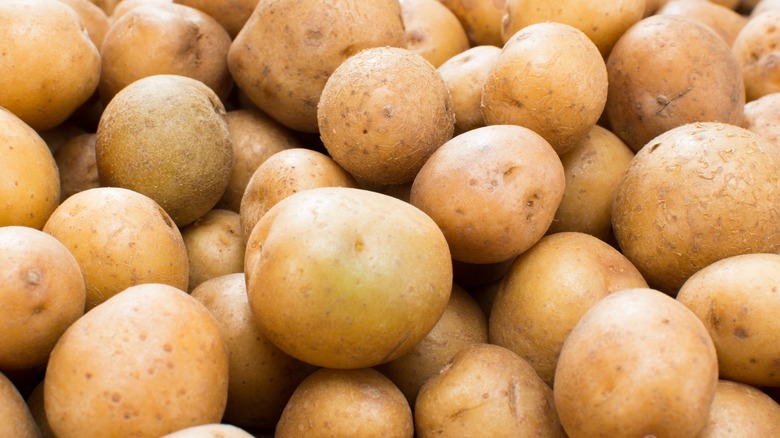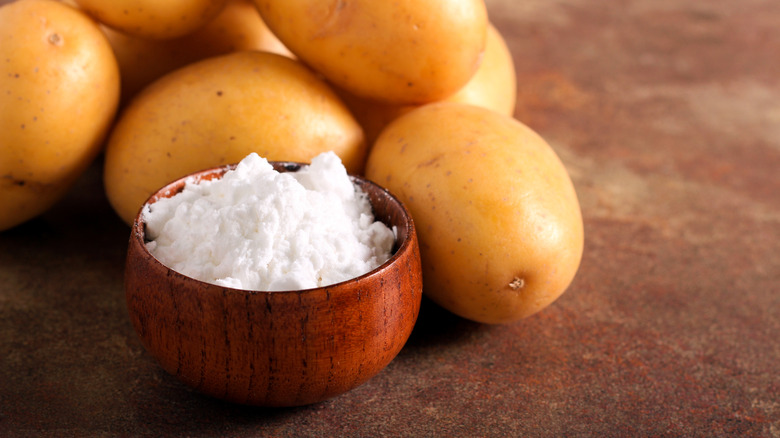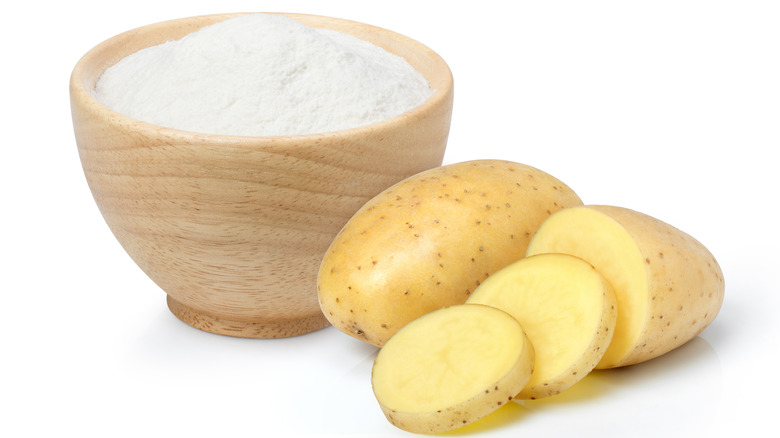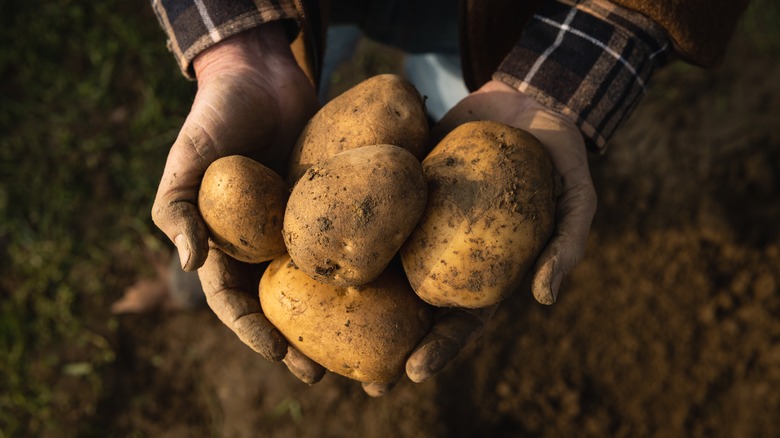Potato Starch Vs. Potato Flour: What's The Difference?
Potatoes make up most of the starchy side dishes we eat nowadays. Think about it – mashed potatoes, french fries, baked potatoes, potato chips, latkes, gnocchi, potatoes au gratin, tater tots, hashbrowns, roasted potatoes, potato salad, and much, much more. These hearty spuds have a lot of uses, and no matter how you slice 'em or cook 'em, they're destined to be delicious. However, the science behind them is another story. Not only do they have an abundance of nutritional value, but their natural starches and chemical makeup have helped create two products that assist in many kitchens globally: potato starch and potato flour.
These two products help add potato flavor to dishes, thicken the consistency of sauces, and more. However, another potato perk is that they're gluten-free, making potato flour and potato starch easy ingredients to swap in for wheat flour when baking. So what exactly are they? Is there a difference between the two? And how do we incorporate them into everyday dishes?
What is potato starch?
First, let's understand what starch is. Scientifically speaking, Serious Eats states that starch is a polysaccharide, a chain of carbohydrates in plants such as wheat, corn, rice, and potatoes. There are two types of starches: native and derived. Native starches occur naturally without any processing, whereas derived starches require chemical extraction. Potato starch is a native starch extracted by crushing potatoes, producing a milky substance. Once the starch is rinsed, it's then dehydrated into a fine, white powder. Potato starch is much larger in granule size than most starches, allowing it to combine with water much more easily.
Without starch, foods like cereal, noodles, and bread would have a completely different texture and consistency. You can incorporate potato starch into just about any dish that needs thickening, such as soups, sauces, fillings, and casseroles (via Medical News Today). You can even use it as a breading for meat when frying foods. If potato starch is not readily available in your area, you may want to think twice before using potato flour in its place. Cornstarch is a better alternative.
What is potato flour?
As Serious Eats notes, potato flour and potato starch are not the same things. Potato starch is essentially just the starch extracted from potatoes, dehydrated, and formed into a white powder, whereas potato flour is a powder made from whole potatoes. Basically, potatoes are cooked, dried, and ground into a fine powder. Izzy Cooking states that potato flour has a potato taste yet has the same look and feel as wheat flour.
Potato flour is more nutritious than potato starch, containing vitamins, minerals, protein, and fiber (per Allrecipes). It's also a wonderful gluten-free substitute to wheat flour, but it's best used in savory dishes, as it can result in a gummy consistency when baked into a sweet treat. Its ability to absorb makes it great for yeasted bread, as a binding agent in meatloaf, or even as a breading for meat. Allrecipes also notes that it is commonly mixed with other types of gluten-free flour.
Nutritional differences
According to Taste Essence, potato flour adopts much of the nutritional value that potatoes have. Potato flour has wonderful sources of thiamine, riboflavin, folate, niacin, and vitamin C and is packed with potassium, calcium, phosphorus, fiber, protein, iron, magnesium, and zinc. These spuds are built not only to satisfy your taste buds but strengthen your immune system.
The starch extracted from potatoes, however, is considered resistant starch, which has several health benefits for the body (per Medical News Today). For starters, resistant starch is a harder starch to digest within the small intestine, which may sound like a negative effect, but it turns out that once it travels into the colon, it begins a fermentation process that feeds good bacteria to your gut. This improves digestion and colon health for those suffering from ulcerative colitis, diverticulitis, and Crohn's disease, sensitivity to insulin which prevents the risk of diabetes, obesity, and heart disease, and can even aid in weight loss.
Are they interchangeable?
According to King Arthur Baking, it's not recommended that the two be used as substitutes for one another when baking gluten-free. However, if you're trying to retain the moisture in yeasted bread and extend the shelf life, there is an exception. Allrecipes states that potato starch can be substituted for potato flour, just not in a 1:1 ratio. Potato flour makes up a smaller percentage of starch than potato starch, so you'll need to use less starch than flour. A recommended conversion would be ¾ cup potato starch to 1 cup potato flour.
An ideal substitute for potato flour is potato flakes. If you're not able to find them, a box of instant mashed potatoes will do the trick. An ideal substitute for potato starch is 1 tablespoon of cornstarch or arrowroot powder for every tablespoon of potato starch and 2 tablespoons of tapioca starch for every tablespoon of potato starch (via Allrecipes).




